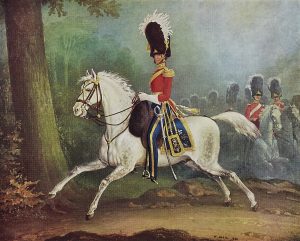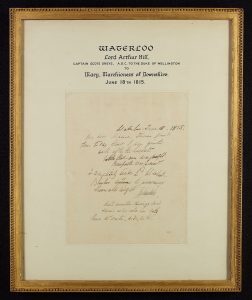Lord Sandys’ letters from the Peninsular War
- 14th November 2025
From the Sandys Archive comes a series of letters from an officer fighting in the Peninsular War.
As a young cavalry officer in the Duke of Wellington’s army, Arthur Moyses William Hill bore witness to some of the most pivotal moments of the Napoleonic Wars. From early 1813 to the aftermath of the Battle of Waterloo, his letters home are a gripping account of his experiences fighting in the Peninsular. Writing mainly to his mother, his stories are enriched by the journal entries of his sisters who record the family’s reactions from home. Together, they paint a vivid portrait of military life and the fight to defeat Napoleon in Europe.

Lord Arthur Hill on horseback, Royal Scots Grey, taken from a painting by William Heath – Reference: 705:56/BA16936
A Noble Beginning
Born on 10th January 1792, ‘Atty’ was the second son of Mary Sandys and Arthur Hill 2nd Marquess of Downshire. As a child, he attended Eton College with his brother – also named Arthur, but who went by Downshire after inheriting their father’s title upon his death in 1801. Atty, meanwhile, became heir apparent to the revived Sandys barony under a special remainder. An inheritance that would later bring with it a love of all things Ombersley.
Into the Saddle: The 10th Hussars
Less academically inclined than his brother, after four years at Eton, Atty entered the Junior Department of the Royal Military College in Great Marlow. As a cadet he expressed a clear preference for the cavalry over the infantry and joined the 10th Regiment of the Light Dragoons (Hussars) when his training was complete. Though he later purchased a lieutenancy in the 24th Dragoons, Atty quickly returned home to the 10th.
The Peninsula to Waterloo 1813-1815
In early 1813, Atty left his Brighton barracks to join Wellington’s army in Europe. Anxious to perform his duty as a soldier, his letters from this period capture the emotional highs and lows of the war’s final years.
After seven weeks in Lisbon, he tells of his march to the Estrella Mountains – a moment that would prove pivotal to the success of Wellington’s campaign. ‘Sometimes up to the horses knees in mud & water. The scenery…grand & wild’. ‘The most tiresome part of our life here’ he writes, ‘is the total ignorance of everything else that is going on at home or abroad.’

Book of transcripts of the letters of Lord Arthur Hill, 20th cent – Reference: 705:56 BA16936/84/11
In 1814, Atty reported from the Battle of Vitoria:
King Joseph left Vitoria minutes before the Hussar brigade charged thru’ the town…The battle began at 8 in the morning and was not over till 8 in the Evng…They say it was the most complete defeat the French ever have had […] The cannon balls came whistling about us much quicker than pleasant…I write this in a ploughed field in my tent, very wet.’
Ten days later, in a letter to his sisters, he recalls how allied soldiers plundered a French baggage train laden with stolen treasures. An event that would later prompt Wellington to rule his men ‘the scum of the earth’. ‘What lots of pretty things I might have got for you’ he tells them. ‘However as I would not allow the men to plunder I cou’d not do it myself. How I blame myself for my consciousness…The ground was strewn will dollars and gold, so you fancy the men got an immense [amount] of money’.
When news broke that Napoleon had escaped from Elba, Atty was back in London. When he learned that a battle in Belgium was imminent, he is said to have galloped all the way to Dover. Where, determined to reach headquarters in time, he bought a rowing boat for £22 and set off across the channel. ‘Well, if he hadn’t been able to buy a boat’, Wellington remarked, ‘I suppose Arthur would have swum’.
By June 1815, Atty was fighting in the Battle of Waterloo. It is here that he wrote his most notable letter – a brief scraw to his mother in the evening immediately after the conflict:
I have just time to say that I am quite well after the hardest battle that was ever fought. Bonaparte was present & completely beat. Ld W expects Blucher is to [sic] pursuing them all night…don’t mention having heard from me as the Duke has not time to write his dispatch.
The next day he continues:
We yesterday fought the hardest battle that ever yet was known, in which we obtained a most complete victory over the enemy […] The action began first about eight in the morning, by the French attacking our right…the enemy came down in great force…They then attacked the left & were repulsed by both Infantry & Cavalry […] it was a miracle the Duke and all of us were not all killed; he was everywhere and led his troops on himself…Percy, myself had our horses wounded…The Dukes horse was not touched. I believe Percy takes the dispatches & will give you this.
Years later, Atty would return to the Waterloo battlefield on a tour with his mother and sisters.

Letter from Lord Arthur Hill, 18th June 1815, mounted in gold frame – Reference: 705:56 BA16936
Battlefield to Barony
In 1836, Atty became 2nd Baron Sandys in the second creation. The Duke of Wellington became a regular visitor to Ombersley Court, where his bedroom over the library became known as the Duke’s Room. This is perhaps unsurprising given Wellington was both Atty’s commanding officer and his cousin. Atty’s father Arthur was the Duke’s second cousin.
Atty’s letters shine a rare and personal light on the final years of the Napoleonic Wars — from mud soaked marches and cannon fire to quiet reflections and family ties. Preserved in the Sandys Archive, they remind us that history is not only shaped by big moments and famous names but also by the handwritten words of those who lived it.
Post a Comment